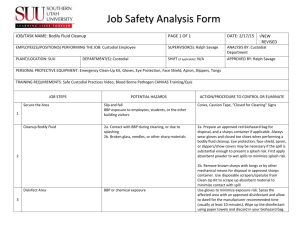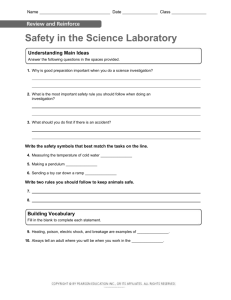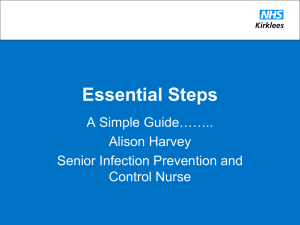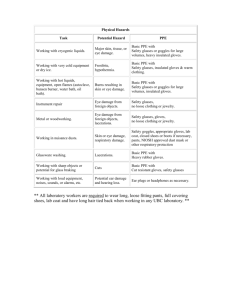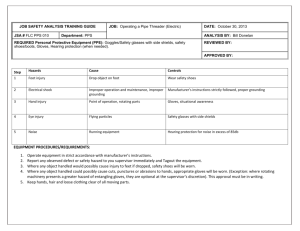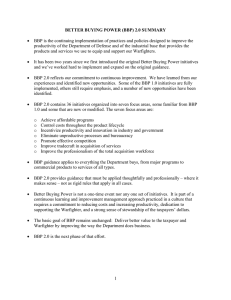Site-Specific BBP Exposure Control Plan
advertisement
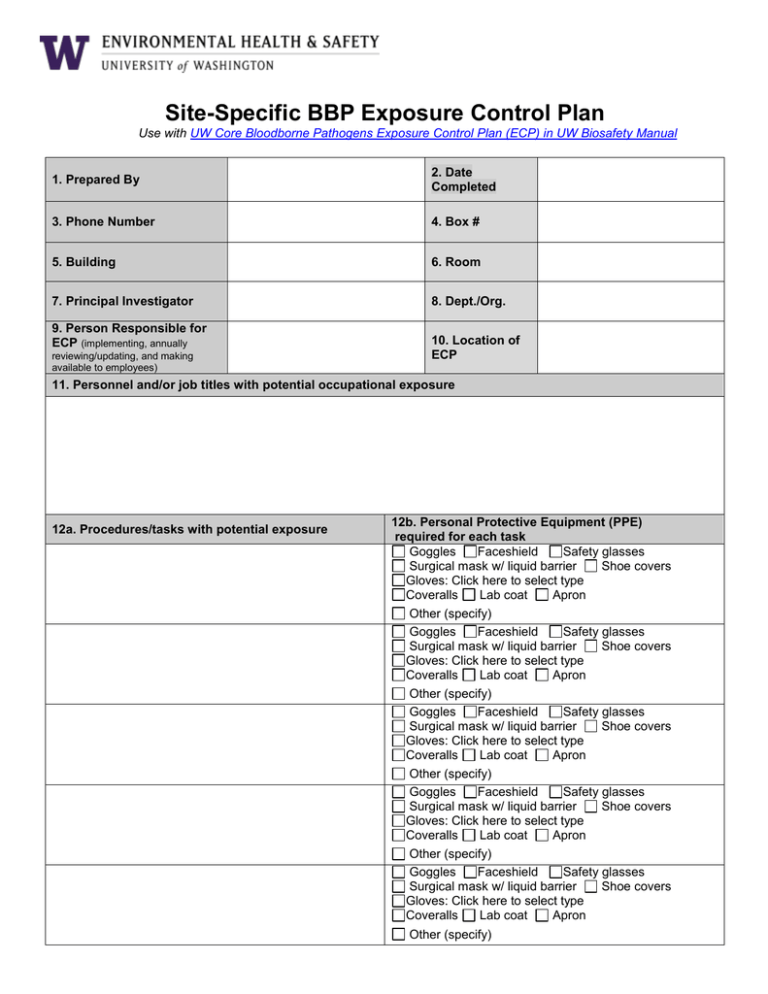
Site-Specific BBP Exposure Control Plan Use with UW Core Bloodborne Pathogens Exposure Control Plan (ECP) in UW Biosafety Manual 1. Prepared By 2. Date Completed 3. Phone Number 4. Box # 5. Building 6. Room 7. Principal Investigator 8. Dept./Org. 9. Person Responsible for ECP (implementing, annually reviewing/updating, and making available to employees) 10. Location of ECP 11. Personnel and/or job titles with potential occupational exposure 12a. Procedures/tasks with potential exposure 12b. Personal Protective Equipment (PPE) required for each task Goggles Faceshield Safety glasses Surgical mask w/ liquid barrier Shoe covers Gloves: Click here to select type Coveralls Lab coat Apron Other (specify) Goggles Faceshield Safety glasses Surgical mask w/ liquid barrier Shoe covers Gloves: Click here to select type Coveralls Lab coat Apron Other (specify) Goggles Faceshield Safety glasses Surgical mask w/ liquid barrier Shoe covers Gloves: Click here to select type Coveralls Lab coat Apron Other (specify) Goggles Faceshield Safety glasses Surgical mask w/ liquid barrier Shoe covers Gloves: Click here to select type Coveralls Lab coat Apron Other (specify) Goggles Faceshield Safety glasses Surgical mask w/ liquid barrier Shoe covers Gloves: Click here to select type Coveralls Lab coat Apron Other (specify) Goggles Faceshield Safety glasses Surgical mask w/ liquid barrier Shoe covers Gloves: Click here to select type Coveralls Lab coat Apron Other (specify) Goggles Faceshield Safety glasses Surgical mask w/ liquid barrier Shoe covers Gloves: Click here to select type Coveralls Lab coat Apron Other (specify) Goggles Faceshield Safety glasses Surgical mask w/ liquid barrier Shoe covers Gloves: Click here to select type Coveralls Lab coat Apron Other (specify) 13. Engineering controls (specify when each is used) Biological safety cabinet: Centrifuge with safety features (specify type of safety feature & when centrifuge is used): Sharps container: Needleless systems: Needles with safety features (i.e. retractable needles. specify type & when each is used): Plastic capillary tubes: Tongs or forceps to handle broken glass: Other (specify type of control & when used) 14a. Sharps containers are inspected, maintained, replaced Whenever necessary to prevent overfilling (no more than 2/3 full) By: Every: 14b. Sharps container decontamination & disposal procedure 15. Work practice controls used to minimize exposure (in addition to universal precautions) No eating/drinking/applying cosmetics in areas with blood and/or OPIM No capping/bending/shearing needles Contaminated sharps are immediately disposed in sharps container No mouth pipetting Gloves changed whenever soiled/torn/punctured and removed prior to exiting work area Follow procedures to properly remove/dispose of PPE Training on use of engineering controls required prior to work Specimens of blood and OPIM transported in secondary, non-breakable, leakproof, sealed, labeled containers outside of lab Hand washing when gloves are removed/changed, before leaving work area, whenever soiled/contaminated Reusable sharps are secured when not in use (specify how and where) Other work practice controls (specify) Follow these standard operating procedures (i.e. use of centrifuge ) ROS Form 601 (04/08, 08/10, 5/15) Document1 Page 2 of 5 16a. How front line workers and management are involved in identifying changes in engineering controls and work practices and evaluating new products/process improvements Employee feedback (specify how and frequency): Safety committee activities (specify which safety committee and frequency): Exposure incident investigation: Laboratory meetings: Other (specify) Explain: 16b. Person responsible for implementing engineering and work practice recommendations via the process specified in 16a 17a. Location of PPE 17b. Person responsible for providing PPE 17c. The order in which PPE is removed 17d. Procedure for handling used PPE 18a. Laundered articles (if applicable) 18b. Person responsible for laundry (if applicable) 18c. How articles are prepared for laundry and laundered (include laundry schedule) 19a. Procedure and schedule for routine cleaning and decontamination (specify surfaces, equipment, disinfectant and contact time) ROS Form 601 (04/08, 08/10, 5/15) Document1 Page 3 of 5 19b. Spill and decontamination procedures (specify disinfectant and contact time) 20. BBP waste procedures (specify how waste is packaged and disposed) 21. Person responsible for providing lab specific BBP training (required before work with BBP and within 12 months thereafter. Includes training on proper use of engineering controls) 22. Person responsible for reviewing exposure incidents ROS Form 601 (04/08, 08/10, 5/15) Document1 Page 4 of 5 23. EMERGENCY PROCEDURES 1. WASH AREA IMMEDIATELY Wounds and needlesticks: Thoroughly scrub the area for 15 minutes with warm water and sudsing soap. Eye and mucous membrane exposure: Flush immediately at nearest eyewash station for 15 minutes. 2. SEEK CARE IMMEDIATELY Contact the UW Employee Health Center at 206- . After hours go to the Emergency Room. o Be prepared… to give information to the healthcare providers. Tell them you are a UW employee. Have information about the agent and/or animal involved in your injury. Information, such as, agent description, route of exposure, dose or concentration, any unusual characteristics of the agent, animal infection, and PI contact information. Notify Your Supervisor 3. COMPLETE ON-LINE ACCIDENT REPORT: http://www.ehs.washington.edu/ohsoars/index.shtm Signature of PI or Lab Manager Date reviewed/updated (must be within 12 mo of previous review/update) EH&S Resources 1. BBP Program implementation: EH&S Research and Biological Safety, 206-221-7770 or ehsbio@uw.edu 2. EH&S BBP Training Registration (required before work with BBP and within 12 months thereafter): http://www.ehs.washington.edu/psotrain/index.shtm 3. UW Core BBP Exposure Control Plan: Located in the UW Biosafety Manual http://www.ehs.washington.edu/rbsbiosafe/bsmanualindex.shtm Hepatitis B Vaccine Inquiries and Scheduling 1. Main Campus Employee Health Center: 206-685-1026 2. Harborview Medical Center Employee Health Center: 206-744-3081 Regulations and Regulatory Guidance 1. Washington State BBP Standard, Washington Administrative Code (WAC) 296-823 http://www.lni.wa.gov/safety/rules/chapter/823/ 2. National Institute of Safety and Health (NIOSH) BBP Topic Page: http://www.cdc.gov/niosh/topics/bbp/ ROS Form 601 (04/08, 08/10, 5/15) Document1 Page 5 of 5
